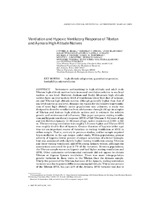Mostrar el registro sencillo del ítem
Ventilation and hypoxic ventilatory response of Tibetan and Aymara high altitude natives
| dc.contributor.author | Beall, Cynthia M | |
| dc.contributor.author | Strohl, Kingman P | |
| dc.contributor.author | Blangero, John | |
| dc.contributor.author | Williams-Blangero, Sarah | |
| dc.contributor.author | Almasy, Laura A | |
| dc.contributor.author | Decker, Michael J | |
| dc.contributor.author | Worthman, Carol M | |
| dc.contributor.author | Goldstein, Melvyn C | |
| dc.contributor.author | Vargas, Enrique | |
| dc.date.accessioned | 2017-03-27T13:38:16Z | |
| dc.date.available | 2017-03-27T13:38:16Z | |
| dc.date.issued | 1997 | |
| dc.identifier.uri | http://repositorio.umsa.bo/xmlui/handle/123456789/9893 | |
| dc.description.abstract | ABSTRACT. Newcomers acclimatizing to high altitude and adult male Tibetan high altitude natives have increased ventilation relative to sea level natives at sea level. However, Andean and Rocky Mountain high altitude natives have an intermediate level of ventilation lower than that of newcomers and Tibetan high altitude natives although generally higher than that of sea level natives at sea level. Because the reason for the relative hypoventilation of some high altitude native populations was unknown, a study was designed to describe ventilation from adolescence through old age in samples of Tibetan and Andean high altitude natives and to estimate the relative genetic and environmental influences. This paper compares resting ventilation and hypoxic ventilatory response (HVR) of 320 Tibetans 9–82 years of age and 542 Bolivian Aymara 13–94 years of age, native residents at 3,800–4,065 m. Tibetan resting ventilation was roughly 1.5 times higher and Tibetan HVR was roughly double that of Aymara. Greater duration of hypoxia (older age) was not an important source of variation in resting ventilation or HVR in either sample. That is, contrary to previous studies, neither sample acquired hypoventilation in the age ranges under study. Within populations, greater severity of hypoxia (lower percent of oxygen saturation of arterial hemoglobin) was associated with slightly higher resting ventilation among Tibetans and lower resting ventilation and HVR among Aymara women, although the associations accounted for just 2–7% of the variation. Between populations, the Tibetan sample was more hypoxic and had higher resting ventilation and HVR. Other systematic environmental contrasts did not appear to elevate Tibetan or depress Aymara ventilation. There was more intrapopulation genetic variation in these traits in the Tibetan than the Aymara sample. Thirty-five percent of the Tibetan, but none of the Aymara, resting ventilation variance was due to genetic differences among individuals. Thirty-one percent of the Tibetan HVR, but just 21% of the Aymara, HVR variance was due to genetic differences among individuals. Thus there is greater potential for evolutionary change in these traits in the Tibetans. Presently, there are two different ventilation phenotypes among high altitude natives as compared with sea level populations at sea level: lifelong sustained high resting ventilation and a moderate HVR among Tibetans in contrast with a slightly elevated resting ventilation and a low HVR among Aymara. | es_ES |
| dc.language.iso | en | es_ES |
| dc.publisher | American Journal Physical Anthropology | es_ES |
| dc.subject | ADAPTACIÓN A LA ALTURA | es_ES |
| dc.subject | GENÉTICA CUANTITATIVA | es_ES |
| dc.subject | HEREDABILIDAD | es_ES |
| dc.subject | MICROEVOLUCIÓN | es_ES |
| dc.title | Ventilation and hypoxic ventilatory response of Tibetan and Aymara high altitude natives | es_ES |
| dc.type | Article | es_ES |

